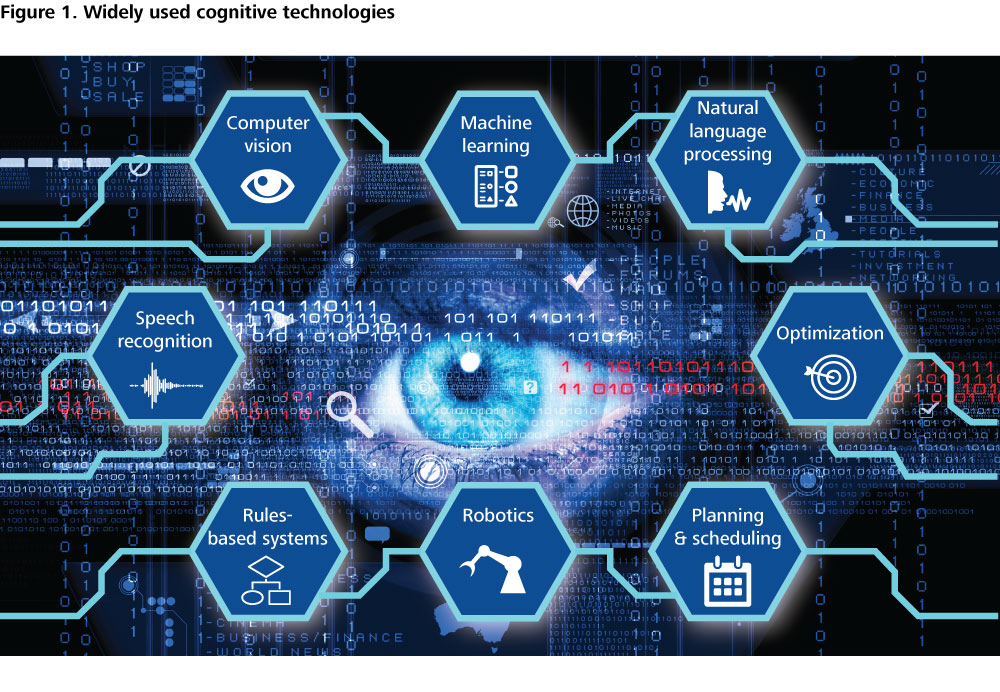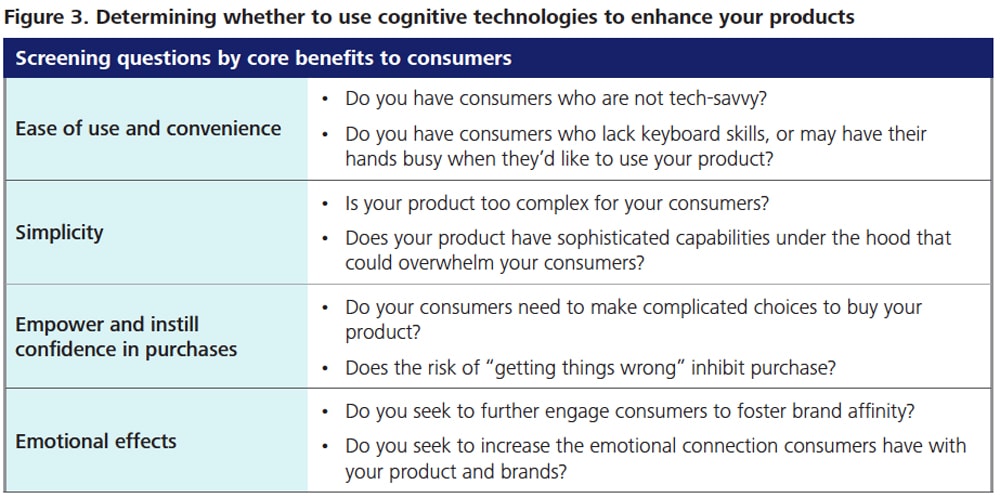The thinker and the shopper has been saved

The thinker and the shopper Four ways cognitive technologies can add value to consumer products
04 June 2015
The time could be ripe for consumers and consumer products companies to embrace cognitive technologies, which can offer companies ways to deliver benefits to consumers to a greater degree than previously possible.
Introduction
Isabella was skeptical. Date night with her husband—the first in a long time—was four days away, and with the kids, dog, house, and a job, she had zero time to make it to the makeup counter at the mall. Using a smartphone to try on makeup? Really?! Well, here goes nothing, she thought. But after she downloaded the application with ease, Isabella found herself smiling as her selfie appeared with just one click. Her screen had just transformed—quite magically—into a makeup mirror! The experience was a little odd at first, but applying eye shadow virtually was a cinch, sans the mess of testers. Isabella appreciated having the leisure to find just the right shade of foundation for her uneven skin tone without being subjected to a hard sell from the counter girls. The hardest part was, ironically, the most fun: choosing between a coral or a tropical lipstick without having to feel apologetic for her indecisiveness. Look complete, Isabella saved the selfie and posted it to Facebook after sharing it with her younger sister, who’d clued her in to the app. “Tots fab!” someone soon posted to her wall. “Why didn’t this exist sooner?” Isabella texted to her sister, who replied immediately, “I know!” Able to order the products directly through the app for two-day delivery, Isabella felt confident and ready for her special evening with her own prince.
New ways to create value
Cognitive technologies can give makers of household goods new ways to create value for consumers like Isabella. These technologies, derived from the field of artificial intelligence (AI), can enhance the consumer experience across the purchase life cycle, from pre-store planning through the in-store experience, product usage, and post-purchase interaction.
Many companies are employing cognitive technologies across a wide range of product categories, from durables to staples. The technologies are being embedded in consumer electronics and appliances, for instance, to enable them to seem to see, hear, and think. But while cognitive technologies can create compelling new opportunities for makers of household goods, they should not be applied as merely bells and whistles. Brands can make smart choices about where and how to apply cognitive technologies by understanding the four principal ways they can create value for consumers.
What are cognitive technologies?
It is now possible to automate many tasks that are usually assumed to require human perceptual or cognitive skills. Cognitive technologies is the general term applied to technologies that are able to perform such tasks, which include recognizing handwriting, speech, or faces; understanding language; planning; reasoning from partial or uncertain information; and learning.1
A product of the field of AI, cognitive technologies are not new. Indeed, they have been evolving over decades. Many businesses today are taking a fresh look at these technologies, however, because many of them have improved dramatically in recent years, with impressive gains in machine learning, computer vision, natural language processing (NLP), speech recognition, and robotics, among other areas (figure 1).
Cognitive technologies currently in use include:
- Computer vision: The ability of computers to identify objects, scenes, and activities in unconstrained (i.e., naturalistic) visual environments
- Machine learning: The ability of computer systems to improve their performance by exposure to data without the need to follow explicitly programmed instructions
- Natural language processing (NLP): The ability of computers to work with text the way humans do—for instance, extracting meaning from text or even generating text that is readable, stylistically natural, and grammatically correct
- Speech recognition: The ability to automatically and accurately transcribe human speech
- Optimization: The ability to automate complex decisions and trade-offs about limited resources
- Planning and scheduling: The ability to automatically devise a sequence of actions to meet goals and observe constraints
- Rules-based systems: The ability to use databases of knowledge and rules to automate the process of making inferences about information
The broader field of robotics is also embracing cognitive technologies to create robots that can work alongside, interact with, assist, or entertain people. Such robots can perform many different tasks in unpredictable environments, integrating cognitive technologies such as computer vision and automated planning with tiny, high-performance sensors, actuators, and hardware.2
Cognitive technologies in consumer products: The time is ripe
Amid uncertain global economic conditions, many consumer product companies in the United States are struggling to drive growth. Concurrently, they are often contending with increasingly value-conscious but tech-savvy and demanding consumers. With more consumers using digital and mobile devices to shop (e.g., reading reviews and comparing prices on their smartphones), many consumer product companies are beginning to invest in and use a myriad of existing and emerging technologies to better understand, connect with, and engage with consumers.3
Digital interactions influence more than one-third of retail in-store sales.
The confluence of certain trends may signal consumer readiness for, and consumer product manufacturer willingness to invest in, cognitive technologies:
Digitally empowered comparison-shopping consumers. Nearly two-thirds of respondents to Deloitte’s 2014 annual holiday survey reported owning a smartphone,4 and prior research has found that 58 percent of consumers who own mobile devices use them in-store while grocery shopping.5 Digital devices and apps that are easy to use, provide better information during shopping, and enable customers to compare prices online or locate coupons for saving money have become a must for many value-seeking consumers. Consumer access to mobile devices and familiarity with the digital experience can present an opportunity for cognitive technologies to underpin a more natural interface with the consumer.
Growth of digital commerce for consumer goods. Growth in online retail sales in the past decade has been significant, with e-commerce now accounting for over 5 percent of the $4.3 trillion in total US retail sales.6 Furthermore, digital interactions influence more than one-third of retail in-store sales.7 While online sales of food and beverage products are nascent (though increasing), e-commerce penetration in other consumer goods categories is now mainstream: Online clothing and footwear sales, for example, represented almost 15 percent of total US retail e-commerce in 2012 and an estimated 17 percent in 2014.8 As many consumers increasingly embrace digital engagement, there tends to be greater acceptance of the potential digital delivery mechanism for cognitive technologies.
Investments in digital technologies. Consumer product companies are expected to increase investment in new technologies to influence the consumer’s path to purchase and product experience, according to a recent survey of consumer product executives. More than two-thirds of executives indicated they expect to increase near-term investments to improve mobile e-commerce applications and services, with nearly two-thirds likely to invest more in device interfaces or screens to enable greater interactivity and ease of use.9
How cognitive technologies can benefit consumers
Isabella cautiously approached her new laundry machine. She tossed in her laundry load and, with a leap of faith, softly said, “Start wash.” The new laundry machine did not require her to select water level, temperature, cycle length, or even pouring in laundry detergent and softener. Somehow the machine weighed and scanned the laundry to determine the best settings. At first, Isabella had been skeptical about the lack of buttons and dials and the machine’s ability to assess the best washing characteristics, but over time, she noticed that the machine reliably produced clean clothes. Furthermore, the machine tended to use less water and detergent, and to select shorter cycle times than she would have on her own. Isabella’s young son, Lucas, had nicknamed the talking laundry machine “Washy,” and enjoyed peppering “him” with questions like “Washy, when will my shirt be clean?” and hearing “him” affectionately respond “I won’t be long!” Isabella also appreciated the voice reminders of when to place the washed clothes in the dryer and reload the machine with detergent.
In a study of over 100 applications and pilots of cognitive technologies across 17 sectors, we found that most applications fall into three main categories: enhancing products or services, automating processes, and uncovering insights that can inform operational and strategic decisions.10 Our focus here is on ways that some consumer goods companies are using cognitive technologies, in all three ways, to create more valuable experiences for consumers.
To this end, we have reviewed over 40 examples of consumer product companies—across staples and durables sectors—that have implemented or piloted an application of cognitive technologies to help improve functionality, simplify design, or offer services that significantly enhance the user experience. In studying these examples, we identified four core ways in which such products generally benefit consumers:
- Ease of use and convenience
- Simplicity
- Empowering consumers and instilling confidence in purchases
- Emotional effects
Though these benefits may not be new, products with cognitive technologies can provide new avenues for delivering these potential benefits—to a greater degree than previously possible—to consumers.
Ease of use and convenience
Intuitive interfaces can help consumers quickly control devices. When intuitive interfaces are wedded with cognitive technologies, consumers may not only benefit from easier navigation but also rapid and effective understanding and fulfillment of their intentions and goals. For instance, using a keyboard to type out grocery lists or keywords to search the Web for recipes can be tedious. Speaking is easier. Speech recognition technology accurately transcribes voice commands in real time to allow users to easily create grocery lists or retrieve recipes hands-free—in the kitchen or car—making shopping and cooking more convenient.11
Speech recognition has enabled a new hands-free way to engage with devices, generally making them easier and more convenient to use. For example, Kraft’s iFood Assistant mobile app enables consumers to search for grocery items and recipes using their voice, and to build and save grocery lists.12 One of the leading mobile lifestyle apps for time-starved consumers since its launch in December 2008, iFood Assistant was upgraded to include voice recognition technology in early 2012.13 In addition to driving users to Kraft products and increasing sales, the app registers and learns from consumer interaction, validating consumer purchase intentions or discerning ways to motivate customers to try a new product or purchase more of a product.14
Likewise, Sharp’s Cocorobo robotic vacuum cleaner, brought to market in June 2012, accepts voice commands, eliminating the need for manual control.15 The Cocorobo uses interactive voice recognition technology and utters phrases, such as “I’m stuffed” when full, in three languages—freeing consumers from manual tasks while providing human-like communication. In its first year on the market, 100,000 Cocorobo units were sold.16 The company has since released a talking microwave using the same Cocorobo “engine,” and aims to release other appliances incorporating AI technologies. “AI is a key path in the development of home appliances,” says a Sharp executive.17
Cognitive technologies to help improve internal business processes
While this article focuses on cognitive technologies that are embedded in the product or directly enhance the consumer experience, cognitive technologies can also be used to enhance internal business processes. In the realm of marketing, cognitive technologies such as natural language processing and machine learning are being used to monitor, scan, and analyze consumer sentiment expressed in social media. For example, one household consumable goods manufacturer has been monitoring social media for several years to better understand consumer sentiment about their products, and recently began using a natural language processing tool to help reduce the man-hours needed to clean up and make sense of sentiment.18 Doing so has enabled the company to quickly sift through hundreds of thousands of social posts to accurately identify consumers most receptive to being engaged by the company.19
Inventory management is another area in which cognitive technologies could help improve performance and drive down costs. Cognitive technology applications could gather, analyze, and send real-time information to consumer products manufacturers to help them more effectively manage inventory and fulfill orders. The information could include anything from economics data and weather forecasts and updates to retailer point of sale and supplier data and customer purchase histories and preferences—all available instantly in a single view, along with the system’s recommendations on ways that managers might respond.
Cognitive technologies can also help consumer products companies reduce the need for human labor and intervention in business processes while enhancing the speed of process and quality and integrity of products. A number of consumer products companies use computer vision systems for inspection and quality assurance purposes during manufacturing and packaging stages. For instance, one personal care manufacturer has implemented a machine vision system to automate inspection of caps and labels during the manufacture and packaging of deodorant. Production speed and performance were improved, with marked decrease in product defects and rejects, and human assets were able to be redeployed to more complex tasks in shop.20
Cognitive technologies can also help fulfill customers’ desire to efficiently resolve issues or receive product information at their own convenience. (As evidence of this desire, 96 percent of consumers first visit a company’s website rather than calling customer service.21) Many consumer goods companies have responded with online assistants that use NLP to understand customer questions, uncover intent, and deliver instant, stylistically natural responses.22 The potential benefits include extracting meaning from text or even generating text that is readable, stylistically natural, and grammatically correct, leading to a more natural user interface and a simpler design that typically reduces learning complexity for the user.
One example is Chip, The Coca-Cola Company’s virtual assistant, which uses natural language understanding to replicate the cadence of human conversation while responding to some 30,000 customer queries per month at the MyCokeRewards.com site. Consumers receive real-time responses and are able to resolve issues day or night. The Coca-Cola Company now views Chip as a brand ambassador.23
As another example, L’Oreal USA developed a Diagnose My Hair application that uses NLP to recreate personalized, in-store hair consultations for customers. The tool enables a non-repetitive exchange in which consumers can ask questions and receive product recommendations that may best suit their needs. The software instantly generates prose responses written in plain English, at no marginal cost to the company.24
The business value of creating automated assistants is clear: They can not only enhance the consumer experience by providing instant, on-demand service, but also help reduce labor and operational costs by streamlining call center and customer service operations. Automating the contact center generally reduces operating costs and can have quantifiable ROI (for example, virtual interactions fielded by The Coca-Cola Company’s Chip cost pennies versus $5–$10 per live-agent interaction), while the L’Oreal app provides the consumer with an “on-brand experience.”25
Benefits can be heightened when multiple capabilities are integrated to automate more complex tasks than would be possible with only a single type of cognitive technology.
Simplicity
Products with a simplified design, with few to no touch points or knobs and that can understand and respond to speech, are typically easier to use. When products with those attributes are also imbued with machine learning and intelligent automation, they can take the work out of learning the technology. The minimalist Aether Cone speaker, for instance, a Wi-Fi connected speaker that predicts and plays what users want to hear, is good to go out of the box—no wires to hook up, no manuals to read—requiring only a spin of the dial and thereafter a user’s voice to learn his or her habits and proactively serve the owner.26 The product, which began shipping in June 2014, contextually learns habits by noting what songs users skip, listen to, or request with every spin of its dial or by voice command.27 Machine learning is the core technology at the heart of the gramophone-shaped object, which adjusts and builds a personalized profile of musical tastes that connects users to the sounds they love while taking the work out of using technology.28
Household appliance makers have perhaps been the most active in using cognitive technologies to simplify consumers’ interactions with products. Indeed, appliance companies have been working for years to develop and commercialize smart products using cognitive technologies: More than 10 years have passed since the Roomba® Vacuum Cleaning Robot came to market in 2002.29 Since then, intervening rapid advances in cognitive technologies and robotics have converged in the heart of the home—the kitchen—where microwaves, dishwashers, and other appliances have become increasingly intelligent, interactive, and connected. Effective robotic applications in household products offer the promise of a connected household, providing early movers potential opportunities to create new product categories, increase sales, and gain competitive advantage.
Empower consumers and instill confidence in purchases
Many apparel and cosmetic companies have begun providing tools that leverage machine learning to provide higher-quality, more personalized information to help consumers find the right style and fit—and/or tools using computer vision that enable users to visualize their options. Both are likely to increase a consumer’s satisfaction with purchases. For example, the True Fit application on Guess’s websites enables consumers to create a profile based on fit and style preferences; the app can provide recommendations within a minute using machine learning algorithms.30 L’Oreal’s Makeup Genius app, likewise, brings the expertise of in-store makeup counter professionals to users’ phones, giving consumers the power to try innumerable combinations at home to find just the right products.31
Recent applications of computer vision let consumers use their smartphones to snap a picture of a product, its barcode, or even themselves to receive multiple purchase options. Such applications can enable consumer goods companies and retailers to differentiate themselves from competitors, improve the in-store experience, increase the effectiveness of marketing campaigns and promotions, and potentially drive sales.32 ThirdLove offers a mobile app that permits users to find “perfect fit” undergarments in the privacy of their own homes. Computer vision is used to make measurements that are fed into an algorithm that gives consumers options from company inventory.33
L’Oreal’s Makeup Genius mobile app, which uses facial recognition software, enables users to scan their features to virtually test cosmetic products before making a purchase decision, as well as share new looks with friends via social media.34 Likewise, another cosmetic company is helping consumers connect with its brand through a virtual skin care consultation tool that allows consumers to upload a photo and use facial recognition technology to view simulations of skin care product usage over time.
Machine learning can provide more personalized, contextual, and anticipatory service during the entire path to purchase. For example, Guess is among 20 brands that have integrated the True Fit machine learning software into their web and mobile platforms. Variations in sizing among brands are a challenge for many online shoppers, with one in four returning items due to incorrect size selections.35 The True Fit engine uses algorithms to match consumer preferences with clothing or footwear that offers the best fit. The tool then leverages its machine learning capabilities to track returns and successful purchases, enabling it to increasingly tailor its recommendations to users. Consumers can become more confident about the tool’s recommendations, and a reduced incidence of returns decrease inconvenience and costs for both the company and customer.36
Benefits can be heightened when multiple capabilities are integrated to automate more complex tasks than would be possible with only a single type of cognitive technology. As an example, one apparel manufacturer is developing a virtual personal shopping assistant that aims to act like an experienced in-store salesperson. The prototype app, Expert Personal Shopper, was developed by Fluid Inc. using IBM’s Watson platform. Speech recognition enables customers to interact via voice with the app, which uses NLP to understand customer questions so that it can make appropriate recommendations based on its analysis of product information. Machine learning is used to improve the quality of the app’s recommendations over time. By using the app to provide personal touches commonly associated with the in-store experience, the company may convert more users into buyers by giving the consumer a more personalized and satisfying shopping experience.37
Emotional effects
Creating an emotional connection with customers—“brand affinity,” “loyalty,” “engagement”—is usually integral to a consumer product company’s marketplace strategy. Here, too, cognitive technologies can help organizations create experiences that prompt the desired emotional response. PepsiCo and Frito-Lay have used image recognition to drive in-store promotion and consumer engagement via contests in which customers photograph their products to vie for prizes.38 Nestlé has done likewise, using computer vision to verify photo entries for its Skinny Cow brand WoCave (“Woman Cave”) Instant Win Game.39
Nor is brand affinity the only emotion that cognitive technologies can help provoke. At least one consumer product company has developed a cognitive technology-enabled product designed to provide direct emotional benefits—such as basic companionship and a sense of well-being—to the consumer. Late in 2014, Nestlé SA began deploying a cadre of waist-high conversational robots at retail stores in Japan to chat up and entertain customers while gaining fresh insights to drive marketing and boost sales of its Nescafe coffee capsules and machines. The Pepper series of bots are touted as capable of understanding and responding to human emotion. The company plans to add 10,000 as sales clerks by end of 2015 to enhance the customer experience and collect consumer opinions.40 Though currently Nestlé is anchoring Pepper robots in stores to engage with and provide basic service for customers, within a year, Pepper's manufacturer, Aldeberan, aims to sell Pepper in the United States to businesses and individuals to “help people grow, enhance their life, and facilitate relationships.”41
Perfecting anthropomorphic design, in which human appearance and communication are more fully realized, tends to be a grail of sorts in the field of robotics. The intent is to increase familiarity with and acceptance of robots, and potentially foster greater emotional connection with users. In the recent film Robot & Frank, the lead forges a touching relationship with his robotic “butler.” Though such a scenario is not yet real, a number of consumer-facing products animated by cognitive technologies already entertain, amuse, and foster affinity with users. The relationship between home appliances and users will become closer, a Sharp executive posited recently, underpinned by advances in artificial intelligence.42
Where to apply cognitive technologies in consumer goods
Consumer goods executives often face a particular set of challenges and critical questions that should be addressed when developing and commercializing products with cognitive technologies. Not all product offerings are good candidates for integrating cognitive technologies—and not all applications will create value for consumers. Executives should prioritize applications that provide compelling enough benefits and value to consumers to drive significant adoption, purchase, or use.43
Though this list is not intended to be comprehensive, we offer several questions that consumer goods executives might consider to inform their decisions on cognitive technology adoption (figure 3).
The future of cognitive technology for consumer goods
Isabella finally had a few moments to herself. Her children were asleep, and she was flipping through the latest catalog from her favorite clothing retailer. She switched over to her tablet to “try out” some yoga pants. The number of styles, colors, and sizes in the paper catalog were a bit overwhelming. Fortunately, the retailer’s application recommended a few styles, colors, and suggested the correct size based on prior purchases and her avatar with her body dimensions. At first, Isabella had been reluctant to have her body scanned for her avatar, but she found that, having done so, she was purchasing more clothes with the desired fit and making fewer returns. The application seemed to know her favorite colors and the types of patterns she preferred based on prior purchases, which made shopping more enjoyable.
The capabilities of cognitive technologies are steadily improving. Not only are computer systems getting better at recognizing faces and understanding speech, but they are also becoming competent at reading human emotions.44 We will likely continue to see new applications of machine learning that can help improve the shopping experience, make products work better, and even understand and anticipate consumer wants and needs. A dramatic example: Last year, Amazon received a patent for “anticipatory shipping,” a method to start delivering packages even before a consumer has placed an order.45
Cognitive technologies are destined to play a larger role in how consumers discover, select, purchase, receive, use, and get assistance with consumer goods. These technologies are opening up vast possibilities for many consumer goods companies to make consumers’ lives easier and simpler, to alleviate uncertainty and help increase confidence in purchases, and to help consumers delight in and even bond with products. As these technologies become more widely adopted, consumer expectations and behaviors are likely to evolve. Just as most consumers have come to expect high-quality online and mobile shopping experiences, they are likely to increasingly expect the features and experiences that cognitive technologies provide.
Consumer goods makers can prepare for this emerging world by reviewing their product, marketing, retail, and customer service strategies. They may uncover opportunities where cognitive technologies can be used to provide consumers with greater value and superior experiences. They should make sure their design teams understand how technologies such as voice recognition, natural language processing, and computer vision make it possible to design natural interfaces. They should equip product developers to know how to create simple and elegant user experiences by hiding complexity with technologies such as machine learning. And they should be able to collaborate with data scientists to combine, analyze, and learn from data from diverse sources to automate, enhance, and guide consumers’ experiences.
Deloitte* is a leading presence in the consumer products industry, providing consulting, audit, risk management, financial advisory, and tax services to more than 80 percent of the Fortune 500 consumer product companies. Deloitte Consulting LLP’s Consumer Products Enterprise Analytics, Big Data, and Digital Disruption offering enables organizations to use data more effectively to inform decision making, pursue business strategy, and deliver breakthrough performance through enterprise insights strategy, advanced analytics, business analytics implementation, enterprise data management and governance, analytical talent management and acquisition, and a variety of on-demand managed analytics solutions targeting pressing issues and opportunities facing consumer product companies. For more information about the Enterprise Analytics, Big Data, and Digital Disruption offering, contact Ben Stiller (bstiller@deloitte.com).
*As used in the above, Deloitte means Deloitte & Touche LLP, Deloitte Tax LLP, Deloitte Financial Advisory Services LLP, and Deloitte Consulting LLP.
© 2021. See Terms of Use for more information.









